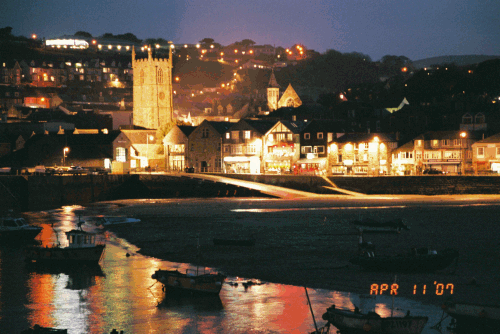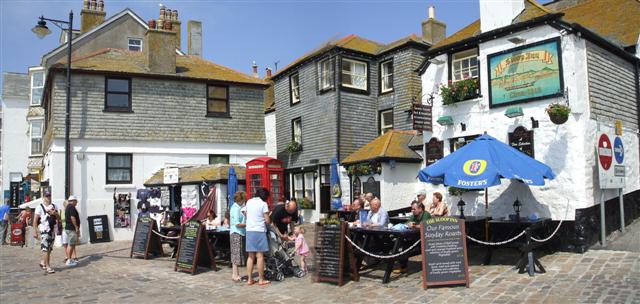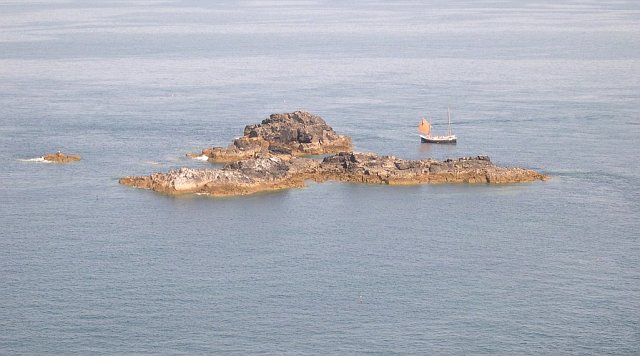As I was going to St. Ives,
I met a man with seven wives,
Each wife had seven sacks,
Each sack had seven cats,
Each cat had seven kits,
Kits, cats, sacks, and wives.
How many were going to St. Ives?
Perhaps the main thing most people know about this Cornish seaside town is the old poem/nursery rhyme/riddle As I was going to St Ives. This anonymous poem was originally printed around 1730 – but in that version there were nine wives. The modern version, with seven wives, appeared in 1825. Although there are a number of St Ives in England and elsewhere, the poem is generally thought to refer to the one in Cornwall.
The answer to the question in the last line is usually assumed to be that only one person is heading towards St Ives while the others – wives, cats or kits – are heading away from the town. But the poem gives us no indication of the direction in which the others are heading. It has been suggested that the person going to St Ives could even have overtaken the party as they were also heading to St Ives!
This little video was uploaded to YouTube by Appuseries. I have to admit, I’ve never heard the poem sung before but it’s very sweet.
We visited St Ives in June 2016 on the first whole day of our stay in Cornwall. It was the third site we visited that day, and we didn’t spend too long there, but we managed to take a few photos. For this post I’ve used several images from Wikipedia to illustrate places we didn’t get to see.
To start with here’s a location map…
St Ives is one of Cornwall’s most famous destinations. It is situated to the north of Penzance on St Ives Bay at the edge of the Celtic Sea. The name of St Ives is attributed to the Irish Saint Ia the Virgin in the 5th century, and the old town is clustered around the parish church of St Ia, built in the 15th century. The church can be seen clearly in this nighttime photo:

Since medieval times fishing has been of great importance to St Ives and the town became one of most important fishing ports on the north coast of Cornwall. The Sloop Inn on the Wharf dates from 1312 and is one of the oldest in Cornwall. It was a fisherman’s pub for many centuries, a reminder of the town’s importance – and former dependence – on fishing:

Commercial fishing is very reduced today but the harbour is still in use, often for recreational boating and tourist fishing, and since 1930, people have been taking boat trips out to Seal Island, 3.5 miles/6km to the west of St. Ives. The island is home to over 40 seals.

Today, St Ives has become primarily a seaside resort, renowned for its working harbour surrounded by beautiful beaches. The irregular coastline ensures sunlight on the different beaches throughout the day. There are four main beaches, two on either side of ‘The Island’ which is also known as Pendinas. It is not an island at all but a promontory. On the photo below, taken from above Porthmeor Beach, the small Chapel of St Nicholas can be seen sitting on top of Pendinas. The one-roomed granite building was an ancient fort and has become a birdwatchers’ paradise. Of the four beaches, we managed to visit two of them, one on either side of Pendinas: Porthmeor Beach and the Harbour Beach.
The town boasts art galleries, cafes, restaurants pubs and shops and is known for its quaint streets and alleys. There are also many old fishermen’s cottages we didn’t have time to see, as well and one of the four Tate Galleries in the world. After we’d spent time at Carn Euny and Land’s End, our visit to St Ives was pitifully short, but it was enough for us to get the general feel of the place.
These few images from Wikipedia give more of an overview of St Ives than we were able to get:
We headed into St Ives along the northern coast and parked on a road up on the hillside looking down on Porthmeor Beach. These photos were taken as we walked towards the town centre. To the right in the first photo is the lifeguard station:
We then turned into the town centre and took a few photos of the streets and shops:
Then we headed across to the lovely harbour where lots of people were enjoying the June sunshine and the ever-present seagulls.
*
On our second day in Cornwall we visited two more of the county’s most famous sites: Tintagel and the Gardens of Heligan. So my next post will be about Tintagel.
*****



























Amazing Post Millie…thank you for the pics of the beaches. The poem in the beginning really created the mood to explore more about this lovely town. Thank ypu!
Thank you, Shivangi. St Ives is a quaint old town and it needs a lot more longer than a couple of hours to do it justice. It was a lovely day when we were there, so we really enjoyed our walk round. 🙂 The poem is so well known, but I think the way it has been made into a song here destroys its natural rhythm.
Thanks for giving me a proper introduction to St Ives.
It’s a pretty little town, Peggy, and full of interesting buildings that hold a lot of history. It does get very crowded in the summer holidays, though. 🙂
Lovely! ❤
Thanks, Timi. St Ives is an intriguing place, especially for a history lover. 🙂
A pretty little village. And always seems to have its own little weather system 🙂
I haven’t looked into the microclimate unique to St Ives, Ali, but I imagine its coastal location on the west (along with the North Atlantic Drift) would keep temps up in both summer and winter – and the moors inland may shield it from incoming winter snows from the NE. But I would also imagine that St Ives gets a fair dollop of rain, thanks to the prevailing south-westerly winds. Other than that…? I’ll have to go and look it up! Lol 😀
(We visited St Ives in late November in !996 when we lived in Devon for a while. According to family still living in Newark, it was snowing there, while we had a gloriously sunny day walking along the Harbour Beach.)
I remember going to St Ives as a kid – it was cloudy all around, but bright sunshine there!
It must be something to do with being so sheltered in St Ives Bay – but whatever, it does seem to be quite unique.
Looks like St Ives is a very popular seaside vacation spot. Which other seaside places are popular in UK?
You’re right, Arv. St Ives is one of the most popular destinations in Cornwall and it gets really crowded in summer. I suppose that gives it a nice holiday atmosphere but it’s very hard to find somewhere to park!
Being an island nation, Britain has dozens of seaside towns, all over the country. They’re all different, depending on the geography of each stretch of coast. In Cornwall, much of the coastline is rugged cliffs, so beaches are very pretty with the cliffs and caves behind. Other parts of the UK have cliffs, too, of course, such as parts of South Wales and North Yorkshire. Some seaside towns are wide stretches of beach with sand dunes and pine woods behind, like my hometown of Southport in Lancashire. All have their own attractions, and some seaside towns (like Blackpool and Southend-on-Sea) are popular because of the fairgrounds, amusement arcades – and night life (which I’m sure they all have!). I dislike fairgrounds but children and young people love them – I know I did years ago. Now I just think they spoil the look of the seafront.
Nowadays, seaside resorts in the UK are struggling to keep going as more and more holidaymakers head abroad to the sun! Since cheaper air fares in the 1970s the main destination for Brits has been around the Mediterranean, mostly to Spain. Now we’ve really spread our wings and destinations are worldwide. 😀
Great to hear all those details. Since you mentioned, Goan beaches in Indiaare also popular among the charter tourists from UK during last many years. some say, that after the 2008 melt down, the number of tourists have come down. But plenty of sunshine, cheap accommodation and food, no language issues have ensured steady flow over the years.
You’re right, I know lots of British people who’ve been to Goa and love it! If I get to India I want to visit historic sites and other notable places, but first we need to decide which part of India to head for.
Ha ha…tough part…There are so many historical sites spread all over the country. 🙂
I have always loved that poem. Wow, St Ives has been around for a long time! I can see why it is a popular tourist spot, it looks so quaint. I always enjoy ‘taking trips’ with you, and I have learned so much 😀
St Ives is a very old town, Antonia, as are most towns in Britain. But St Ives has a lovely quaint appeal and the old harbour is very pretty. The sandy beaches are ideal for children with their buckets and spades and several people brave a dip in the sea – which would probably be far too cold for me nowadays. (Now the Caribbean is a different matter). 😀
An amazing place, I love seaside so much. St Ives can be my favorite!
Thank you, Ann. We loved St Ives, too! It is such a pretty and very quaint old place and the beaches are lovely. 🙂
I can imagine living there!
Beautiful text and photographs. Thank you Millie
Beaches are totally wasted on me, but I love the quaint streets and pubs! Odd that it never occurred to me to wonder what St. Ives was from the poem, or where it might be. How fun that you went there; it’s like finding out a mythical place is real after all. 🙂
St Ives is very quaint and a nice place to visit with or without the beaches, Joy. Beaches in the UK tend to get more family use than people wanting to sunbathe and get a tan. After all, we often have to wait for weeks for a nice sunny day suitable for going to the beach. Buckets and spades are the thing we see most on beaches here and people making sand castles. The sea is usually freezing and only the brave (and kids who don’t seem to notice the cold) venture into the sea – or odd surfers with wet suits on. When I was young, many beaches had people offering donkey rides, which all kids loved. Health and safety nowadays has generally done away with that. Let’s face it, donkey poo on a beach isn’t at all nice! But the idea of donkey rides has gone out of fashion, anyway.
I can understand about not knowing where St Ives is – or even if it existed. I should think there are many people, even in Britain, who don’t give it a thought. 😀
Beautiful pictures – I love St Ives!
Thank you, Laura. St Ives is a pretty place. Unfortunately I can’t get to your site as it tells me ‘the authors have deleted it’.
That’s odd. I have no idea why that has happened! captaincornwallblog.wordpress.com/
I am seriously thinking of going to St Ives, Millie. I can go by boat. Your posts are fantastic.
Thank you, Inese. Sorry for this late reply, but I haven’t been on my blog for the past week. Our elder daughter has just undergone major surgery and ‘blogging’ has been the last thing on my mind.
I’m sure you’ll love St Ives, if you manage to get there. But I could say the same for so many Cornish sites! 🙂
Oh Millie, I hope your daughter is recovering well. Sorry that you all have been in such stress lately. Prayers and good vibes sent.
I am off the blogging myself, just answering the comments. Hope to get back to the tracks on the weekend. ❤
Great piece of words
Now I can say I’ve been to St. Ives! 🙂 Delightful post, Millie. Thanks for sharing.